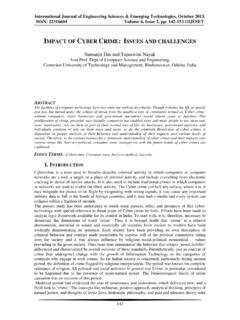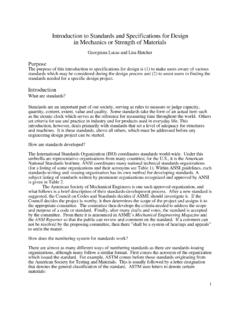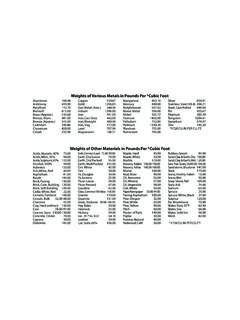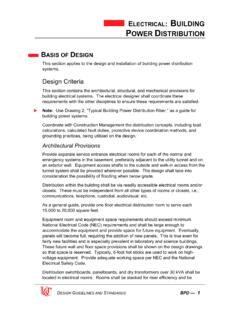Transcription of PRE-ENGINEERED BUILDING DESIGN OF AN INDUSTRIAL …
1 International Journal of Engineering Sciences & Emerging Technologies, June 2013. ISSN: 2231 6604 Volume 5, Issue 2, pp: 75-82 IJESET 75 PRE-ENGINEERED BUILDING DESIGN OF AN INDUSTRIAL WAREHOUSE C. M. Meera Structural Engineering, Regional Centre of Anna University, Coimbatore, India ABSTRACT PRE-ENGINEERED BUILDING (PEB) concept is a new conception of single storey INDUSTRIAL BUILDING construction. This methodology is versatile not only due to its quality pre-designing and prefabrication, but also due to its light weight and economical construction. The concept includes the technique of providing the best possible section according to the optimum requirement. This concept has many advantages over the Conventional Steel BUILDING (CSB) concept of buildings with roof truss.
2 This paper is a comparative study of PEB concept and CSB concept. The study is achieved by deigning a typical frame of a proposed INDUSTRIAL Warehouse BUILDING using both the concepts and analyzing the designed frames using the structural analysis and DESIGN software KEYWORDS: Conventional Steel BUILDING , PRE-ENGINEERED BUILDING , , Tapered I section. I. INTRODUCTION Steel is a material which has high strength per unit mass. Hence it is used in construction of structures with large column-free space. Most of the INDUSTRIAL Structures require this criterion. An INDUSTRIAL Warehouse is a storage BUILDING and is usually characterized as single storey steel structures with or without mezzanine floors. The enclosures of these structures may be brick masonry, concrete walls or GI sheet coverings.
3 The walls are generally non-bearing but sufficiently strong enough to withstand lateral forces caused by wind or earthquake. The designing of INDUSTRIAL warehouse includes designing of the structural elements including principal rater or roof truss, column and column base, purlins, sag rods, tie rods, gantry girder, bracings, etc. A combination of standard hot-rolled sections, cold-formed sections, profiled sheets, steel rods, etc. are used for the construction of INDUSTRIAL steel structures. INDUSTRIAL buildings can be categorized as PRE-ENGINEERED Buildings (PEB) and Conventional Steel Buildings (CSB), according to the DESIGN concepts. The paper starts with the discussion of methods adopted in the study. Introduction to PEB systems and CSB systems are then described followed by the details of case study.
4 Loads and the load combinations adopted for carrying out the analysis of the structure is well defined in the further portions. A section depicting the importance of the software used and the software procedure followed is included. Final portion explains the results obtained from the software analysis of the case study and the inferences from the literature studies. The paper aims at developing a perception of the DESIGN concepts of PEB structures and its advantages over CSB structures. II. METHODOLOGY The present study is included in the DESIGN of an INDUSTRIAL Warehouse structure located at Ernakulam. The structure is a container warehouse of Vallarpadam Container Terminal. The actual structure is proposed as a PRE-ENGINEERED BUILDING with four spans each of 30 meters width, 16 bays each of 12 meters length and an eave height of 12 meters.
5 In this study, a typical PEB frame of 30 meter span is taken into account and the DESIGN is carried out by considering wind load as the critical load for the International Journal of Engineering Sciences & Emerging Technologies, June 2013. ISSN: 2231 6604 Volume 5, Issue 2, pp: 75-82 IJESET 76 structure. CSB frame is also designed for the same span considering an economical roof truss configuration. Both the designs are then compared to find out the economical output. The designs are carried out in accordance with the Indian Standards and by the help of the structural analysis and DESIGN software III. PRE-ENGINEERED BUILDINGS PRE-ENGINEERED BUILDING concept involves the steel BUILDING systems which are predesigned and prefabricated. As the name indicates, this concept involves pre-engineering of structural elements using a predetermined registry of BUILDING materials and manufacturing techniques that can be proficiently complied with a wide range of structural and aesthetic DESIGN requirements, as in [3].
6 The basis of the PEB concept lies in providing the section at a location only according to the requirement at that spot. The sections can be varying throughout the length according to the bending moment diagram. This leads to the utilization of non-prismatic rigid frames with slender elements. Tapered I sections made with built-up thin plates are used to achieve this configuration. Standard hot-rolled sections, cold-formed sections, profiled roofing sheets, etc. is also used along with the tapered sections, as in [3]. The use of optimal least section leads to effective saving of steel and cost reduction. The typical PEB frame of the structure considered for the study is as shown in Figure 1. Figure 1: PEB Frame IV. CONVENTIONAL STEEL BUILDINGS Conventional steel buildings (CSB) are low rise steel structures with roofing systems of truss with roof coverings, as in [3].
7 Various types of roof trusses can be used for these structures depending upon the pitch of the truss. For large pitch, Fink type truss can be used; for medium pitch, Pratt type truss can be used and for small pitch, Howe type truss can be used, as in [1]. Skylight can be provided for day lighting and for more day lighting, North light type truss can be used, as in [1] The selection criterion of roof truss also includes the slope of the roof, fabrication and transportation methods, aesthetics, climatic conditions, etc, as in [1]. Several compound and combination type of economical roof trusses can also be selected depending upon the utility. Standard hot-rolled sections are usually used for the truss elements along with gusset plates, in passing [2]. The CSB frame of the structure considered in the study is as shown in Figure 2.
8 International Journal of Engineering Sciences & Emerging Technologies, June 2013. ISSN: 2231 6604 Volume 5, Issue 2, pp: 75-82 IJESET 77 Figure 2: CSB Frame V. WAREHOUSE PARTICULARS Type of BUILDING : Container Warehouse Type of structure : Single Storey INDUSTRIAL Structure Location : Ernakulam Area of site : 43348 m2 ( ) Type of BUILDING : INDUSTRIAL Warehouse Area of BUILDING : 22979 m2 ( ) Eave height : m Number of spans : 4 Nos Single span width : m Total span width : m Number of bays : 16 Nos Single bay length : m Total bay length : m Support condition : Pinned PEB roof slope : 5 degree CSB roof slope : 15 degree The BUILDING plan of the proposed INDUSTRIAL Warehouse structure considered for the study is as shown in Figure 2. Figure 3: BUILDING Plan International Journal of Engineering Sciences & Emerging Technologies, June 2013.
9 ISSN: 2231 6604 Volume 5, Issue 2, pp: 75-82 IJESET 78 VI. LOADS The loads acting on the structure includes dead load, live load, snow load, wind load, earthquake load, crane load, erection load, accidental load, etc., as in [4]. The load calculation for the structure can be carried out in accordance with IS : 875 1987 and IS : 1893 - 2000. For this structure wind load is critical than earthquake load, as in [8]. Hence, load combinations of dead load, live load, crane load and wind load are incorporated for DESIGN . Dead Load Dead load comprises of self- weight of the structure, weights of roofing, sheets, gantry girder, crane girder, purlins, sag rods, bracings and other accessories, in passing [5]. The dead load distributed over the roof is found to be kN/m excluding the self weight .
10 This load is applied as uniformly distributed load over the rafter while designing the structure by PEB concept. For CSB concept the load is applied as equivalent point load of kN at intermediate panel points and half the value at end panel points over the roof truss. Reference [5] shows the procedure for dead load calculation. Live Load According to IS : 875 (Part 2) 1987, for roof with no access provided, the live load can be taken as kN/m2 with a reduction of kN/m2 for every one degree above 10 degrees of roof slope, explicitly as in [6]. Total uniformly live load acting on the rafter of the PEB structure is found to be kN/m. Similar to dead load, live load is also applied as point loads at panel points for CSB structure and is found to be kN at intermediate panel points and half this value at end points.





